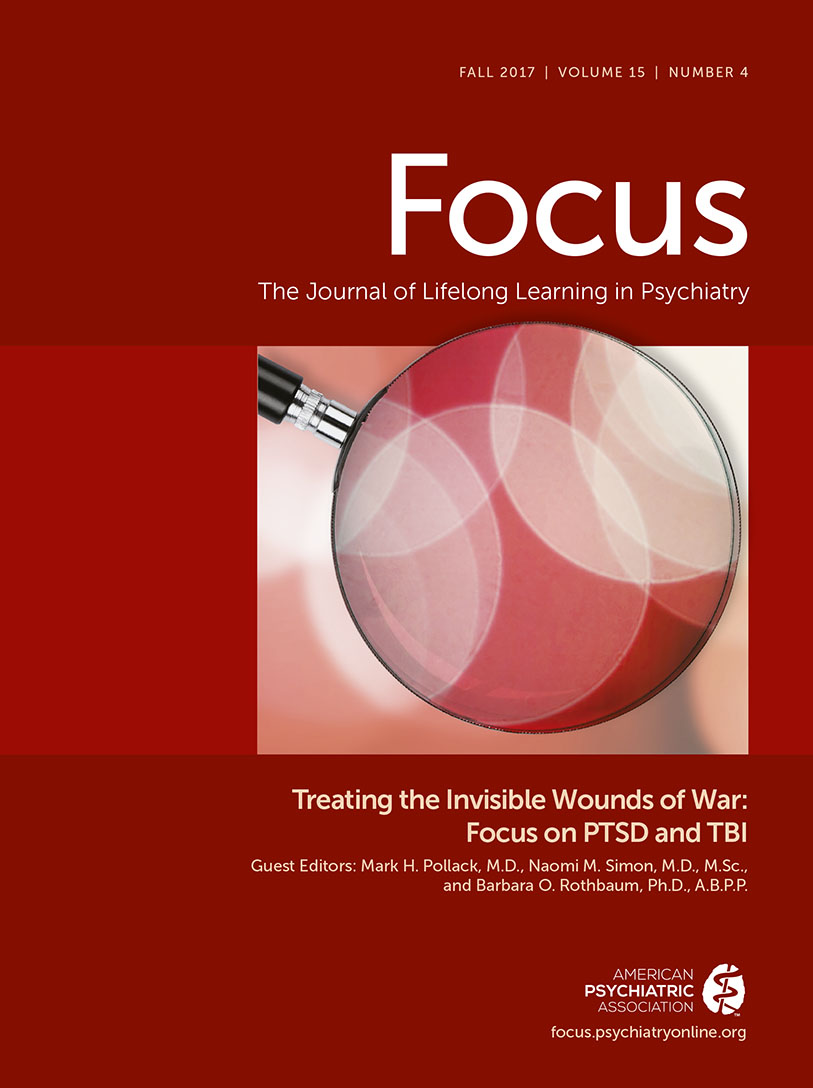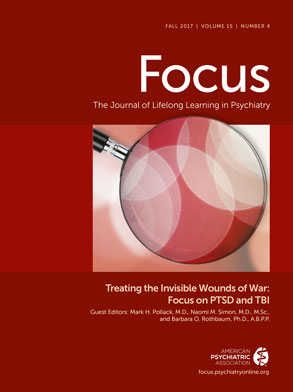“Last week I saw a new patient, Mr. H, who is an Army veteran. He deployed twice to Iraq and has been experiencing flashbacks and nightmares about his time there. I work at a non-VA community clinic, so I don't take care of many veterans. I've read that they are less responsive to treatment than civilians; is this true? What medication and therapy would you recommend for Mr. H?”
Since the beginning of operations in Iraq and Afghanistan, there has been a surge in need for mental health providers who can treat the psychological injuries of warfare among military veterans. Although many veterans receive care at Veterans Affairs (VA) hospitals and clinics, some choose to see clinicians in their home communities outside of the VA for a variety of reasons. It is not surprising that Mr. H made his way to your clinic, and you may see more patients like him in the future. As civilian providers, we should be prepared to support the veterans who have served our country.
Diagnosis
Mr. H is experiencing nightmares and flashbacks, which are among the classic intrusion symptoms of posttraumatic stress disorder (PTSD). PTSD is a disorder that manifests after exposure to trauma, such as the combat-related stressors that Mr. H likely faced during his deployments. For a diagnosis of PTSD, he would need to exhibit, in addition to his intrusion symptoms, avoidance symptoms, negative alterations of cognition and mood, and alterations in arousal and reactivity that cause significant distress and last for at least one month. Other psychiatric conditions that are commonly comorbid with PTSD in veterans, including major depressive disorder, substance use disorders, and traumatic brain injury (TBI), should also be ruled in or ruled out before coming to a final diagnosis. On the basis of the symptoms described thus far, Mr. H could indeed be having PTSD symptoms. The rest of this column will answer your questions from the perspective of treating his presumed PTSD.
PTSD is a “signature injury” of war that affects an estimated 13.2% of Iraq and Afghanistan veterans who have engaged in direct combat since 2001 (
1). You are correct in saying that there are differences between military and civilian PTSD. The index traumas are often dissimilar, with veterans more likely to experience combat-related events. The cultural milieus in which symptoms evolve differ as well, with veterans and service members more likely to be infused with a military ethos of stoicism that can conflict with help-seeking. In addition, the ethical dilemmas of war-related violence, and the burden of responsibility for others under one’s command or in one’s unit, may add a layer of “moral injury” to a veteran’s already traumatic experiences. You are also correct in pointing out that some studies have found a difference in treatment response between military and civilian samples, leading to an ongoing debate about whether that finding indicates a true difference between the populations. We will answer your questions by considering the evidence base for PTSD psychotherapy and pharmacotherapy in military versus civilian populations.
Psychotherapy for PTSD
The evidence base has been rapidly growing in support of the efficacy of short-term, trauma-focused psychotherapies that target PTSD, such as prolonged exposure (PE) (
2) and cognitive-processing therapy (CPT) (
3). On the basis of the evidence available, the VA and Department of Defense (DoD) guidelines for PTSD (
4), in general accordance with those from other international groups (
5), recommend exposure therapies (including PE), cognitive therapies (including CPT), eye movement desensitization and reprocessing (EMDR), and stress inoculation training (SIT) as first-line psychotherapeutic treatments. A decision was made in 2008 to nationally disseminate two of these therapies, CPT and PE, throughout the VA (
6).
Some reviews and commentaries have been less supportive of the research in favor of these evidence-based psychotherapies, particularly when they are merged across many protocols and designs. For example, a Cochrane review (
7) of 70 randomized controlled trials involving 4,761 participants through 2013 found that individual trauma-focused cognitive-behavioral therapies (including PE and CPT), individual non-trauma-focused cognitive-behavioral therapies, EMDR, other therapies (using predominantly non-trauma-focused techniques that would not be considered cognitive, behavioral, or cognitive-behavioral), and group trauma-focused cognitive-behavioral therapies all showed evidence of superiority over waitlist/usual care. In subgroup analyses excluding Vietnam veterans, little difference in outcome, heterogeneity, or effect estimate was found from the overall analyses, suggesting that these veterans do not separate out from the general population. Notably, however, the quality of evidence was very low in these studies when assessed in aggregate, with heterogeneity and publication bias both potentially limiting the interpretability of the findings.
A recent review of psychotherapy for PTSD in veterans (
8) additionally reported that, although within-group effect sizes were large for CPT and PE with clinically meaningful change in 49% to 70%, this leaves the remainder without clinically significant change. Furthermore, the majority (60% to 72%) were not in remission at endpoint. This reflects the treatment-refractory nature of PTSD and the need to further optimize and individualize evidence-based treatments.
Treatment Dropout Rates
PTSD psychotherapy dropout rates have also received considerable attention in the literature as a barrier to care. In Bisson’s review of both military and civilian studies (
7), dropout rates were found to be significantly higher in trauma-focused therapies than in waitlist/usual care, not significantly different between trauma-focused therapies and non-trauma-focused therapies, and significantly higher in trauma-focused therapies than in other therapies (not including EMDR or group therapies). Another systematic review (
9) of dropout rates from PTSD psychotherapy among combat veterans from Iraq and Afghanistan found that approximately one-third of veterans ceased therapy, with no significant difference in dropout rates between exposure therapies and nonexposure therapies. Steenkamp’s review (
8) found that approximately one-quarter of veterans ceased participation in clinical trials for CPT and PE, which is a comparable rate to those in civilian trauma-focused therapies (
10). Overall, regardless of the differences between the dropout rates assessed in various studies, studies have shown that they occur often enough to be concerning from the clinical standpoint of treatment retention.
Pharmacotherapy for PTSD
In PTSD psychopharmacology, selective serotonin reuptake inhibitors (SSRIs) are considered the first-line medication treatment on the basis of the preponderance of the evidence, which has been obtained from both civilian and military samples. A Cochrane review (
11) of 45 randomized controlled trials (N=4,597 participants) involving multiple medication classes (including SSRIs, one serotonin-norepinephrine reuptake inhibitor [SNRI], tricyclic antidepressants [TCAs], monoamine oxidase inhibitors [MAOIs], antipsychotics, anticonvulsants, and novel antidepressants) for both civilians and veterans found medications overall to be superior to placebo in reducing PTSD symptom severity, as evidenced by a response rate of 59.1% on medication versus 38.5% on placebo and a number needed to treat of 4.85. Although the authors were not able to show superior efficacy or acceptability for any particular class of medication, they noted that the bulk of the evidence for efficacy supported SSRIs as first-line pharmacotherapeutic agents, on the basis of the number and size of the studies.
Several medications other than SSRIs, however, are also worthy of mention as potentially efficacious in treating PTSD. A recent meta-analysis of veterans and civilians (
12) comparing pharmacotherapy and psychotherapy for PTSD found that sertraline, venlafaxine, and nefazodone outperformed other medications in decreasing PTSD symptom severity, with paroxetine and fluoxetine treatments yielding smaller levels of improvement. This suggests that not all SSRIs may be created equal and that medications in related antidepressant classes may also be of use (although more studies would be needed to come to a consensus about these hypotheses). Additionally, a recent meta-analysis (
13) of the sympatholytic agent prazosin for PTSD, in a largely veteran and military sample from all eras, demonstrated that it had statistically significant effects in reducing sleep disturbances, including nightmares, in particular as well as PTSD symptoms in general. On the basis of evidence from studies such as these, current VA/DoD clinical practice guidelines for PTSD (
4) recommend SSRIs and SNRIs with a grade A level of evidence; TCAs, MAOIs, and mirtazapine with a grade B level of evidence; first-generation antipsychotics except risperidone with a grade B level of evidence for adjunctive treatment only (risperidone was given a grade D level of evidence); and prazosin with a grade B level of evidence for sleep disruptions and nightmares only.
To answer your question of whether veterans are less responsive to treatment than are civilians, some studies found this to be the case for medications, but overall the data have been mixed. The Cochrane review demonstrated that nonveterans demonstrated a greater reduction in symptom severity after medication treatment than did veterans of all eras. However, the confidence interval between the two groups overlapped, indicating no significant difference in treatment response. Therefore, although some differences have indeed been found between civilian and military responsiveness to medication treatment, no significant differences have emerged thus far between veterans and civilians when medication trials are studied in aggregate. One caveat to these findings is that they are generalized to veterans of all eras. It is possible that post–September 11, 2001, veterans would have a differential treatment response to medications that is not seen in these subgroup analyses.
Combining Pharmacotherapy and Psychotherapy to Treat PTSD
Available data are not clear on how best to combine pharmacotherapy and psychotherapy in the treatment of PTSD, either initially (
14) or with treatment-resistant patients (
15). Novel approaches to combining medications with psychotherapy, using agents targeted to alter the currently understood neurobiology of PTSD, show initial promise. For instance,
d-cycloserine, which is hypothesized to reduce fear through enhanced memory consolidation of new learning and outcomes, has been examined in combination with psychotherapy (
16).
Summary and Recommendations
So where does this leave us, in terms of your questions and Mr. H’s treatment? First and foremost, even the best evidence-based therapies may be ineffective in the absence of a proper diagnosis. In addition to clarifying whether Mr. H in fact meets criteria for PTSD, screening for common co-occurring conditions (among them depression, alcohol and drug use disorders, TBI, and injury-related pain) is necessary, because they can also affect the outcomes of treatments. Once PTSD has been diagnosed, treatment recommendations can be made. Among both veteran and civilian populations, CPT, PE, EMDR, and SIT are among the PTSD psychotherapies best supported by the evidence; and SSRIs (especially sertraline) and SNRIs (especially venlafaxine) can be considered first-line for PTSD pharmacotherapy. Some studies, particularly medication trials, have indeed found differences in treatment response between veterans and civilians. However, it is still unclear why these differences exist or whether they are true differences between the populations. On the basis of the available evidence, both veterans and civilians should be offered the same first-line medications and psychotherapies. As patients with PTSD enter treatment, it is important to remember that treatment dropout is a significant barrier to care for both veterans and civilians. Increasing patient choice and engagement would help to combat this phenomenon in veterans, as would efforts to overcome stigma around seeking mental health care and addressing other treatment barriers related to military culture.
My recommendation for Mr. H, presuming a diagnosis of PTSD, is that you offer him one of the evidence-based therapies, if available. You might also consider an SSRI or SNRI, if needed, such as in more severe cases or when there is an inability to engage in treatment because of impairing comorbid depression. Treatment preference is also an important consideration when helping him choose between medications and psychotherapy; however, psychoeducation plays a key role in guiding treatment selection (
17). Assessing individual needs of the patient and focusing on engagement in care is critical, because no treatment will work if the patient does not use it.

